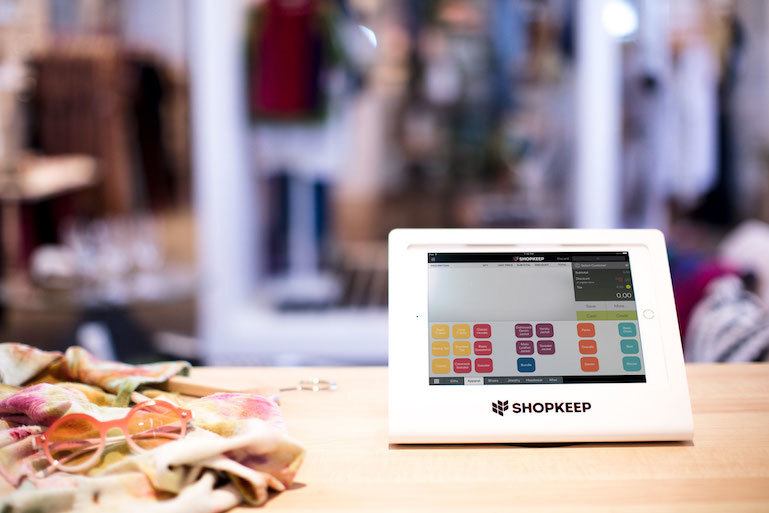
What is Retail Point of Sale Software? Do You Need it?
Almost without exception, today’s tech-savvy retailers rely on point of sale (POS) systems to run their businesses. But if you’re new to retail, or just a fan of the traditional cash register, you might be asking yourself, “What is retail point of sale software?”
It used to be that most small and even medium-sized retailers relied on the traditional cash register as their primary tools for accepting payments from customers. Point of sale (POS) systems were typically reserved for much larger chain stores that could afford their enormous price tag and lengthy, complicated setup process.
However, with the advent of cloud computing, software as a service (SaaS), and cheaper but reliable computing devices like the iPad and Android tablets, POS systems and retail management software, like many other categories of software, were transformed, and now accessible to smaller businesses.
This development, which began in the late 2000s put advanced technology in the hands of your everyday entrepreneur, which resulted in tremendous improvements along the way. So with that in mind, let’s take a deep dive into the ins and outs of retail POS software. If you’re on the fence about whether a POS system is right for your retail business, this article will give you the insight you need to make an informed decision.
What is Retail Point of Sale Software?
At its most basic level, retail POS software is a piece of software that allows merchants to accept payments from customers. In the past, POS software would run on a desktop computer or proprietary piece of hardware. The POS systems used at major retail stores like Target or Best Buy are great examples of what we mean by proprietary hardware. Nowadays, especially if your town has a robust small business community, it’s far more common to see POS software running on an iPad or Android tablet.
Ringing up transactions is just scratching the surface of what most modern POS systems are capable of doing. It’s best to view retail POS software as an all-in-one small business command center or retail management tool, especially if you run a retail business.
It’s pretty standard for retail POS software to include tools for inventory management, employee management, customer marketing, as well as reporting and analytics. Modern retail POS systems also often integrate with other small business tools like accounting software and email
marketing platforms to help streamline operations.
With the above in mind, let’s look at the specific capabilities you can expect from modern retail
POS software.
Key Features of Retail Point of Sale Software
Point of sale software is a vital tool for any merchant that wants to succeed in today’s competitive retail climate. Far from a simple cash register replacement, POS software offers dozens of features that retail stores can use to operate effectively.
Accepting Transactions
Let’s get this one out of the way. Point of sale software wouldn’t be very effective if it didn’t allow a merchant to accept transactions and process payments. When evaluating a potential vendor’s capabilities in this are, there are a few boxes you’ll want to make sure that they check:
Ease of use
Your POS software should offer a clean, modern interface that emphasizes speed and usability. You want something that helps you both check out customers quickly and train new staff on its use.
Multiple Payment Methods
It’s likely that your customers will want to pay with everything from traditional cash to their smartphone. It’s essential to cover your bases and offer support for cash, credit, debit, EMV chip cards, and mobile or NFC payments like Apple Pay and Google Pay.
Multiple Order Entry Methods
Along the lines of ease of use, it’s essential that your POS support various methods of adding items to a customer’s order during checkout. For a retailer, it’s particularly important that you can use a barcode scanner, but you might find that some employees prefer searching for items or adding them with on-screen buttons.

Inventory Management
Outside of running transactions, inventory management is likely going to be the second or third most used tool in your POS software. As a retailer, your business succeeds or fails based on your inventory. Are you selling enough? Do you have the right items in stock? When do you need to place your next order? Are you maintaining a consistent profit margin across your product line? Inventory management tools will help you answer these questions and stay on top of your inventory on a day to day basis. Especially if you have access to real-time inventory data.
Here are a few of the specific features you’ll want your software to have:
Simple Product Creation
It’s likely that you’ll be adding and removing products from your catalog regularly. To make this process as painless as possible, you’ll want the product management tools to be straightforward and intuitive.
Bulk Product Import
This allows you to update a large number of products at once via CSV. This is a huge time-saver when you’re working large orders.
Items With Variants
As a retailer, it’s likely that you’ll be selling items with variants. A typical example is a t-shirt that comes in multiple sizes and colors. Each combination of color and size is a unique product. If your software doesn’t support variants, then managing this type of inventory is going to be very difficult.
SEE ALSO: Why Your POS System is the Best Inventory Management App
Reporting and Analytics
For most retail stores, analytics and reporting are tied with inventory management as retail POS software’s most valuable feature. To ensure you get the most value from your POS software, ensure that your chosen vendor doesn’t skimp on analytical capabilities.
If you’re new to the term, reporting and analytics refer to the process of taking data related to your business, analyzing it, and visualizing it so that you can answer questions about your business. A few common examples include:
- What were my total sales yesterday?
- What is my top selling product this month?
- What was my labor cost for a given date range?
Reporting and analytics are broad concepts, and their implementations in software can range from simple to extraordinarily complex. For most small business owners, that means erring on the side of simplicity, while ensuring there’s still room to grow as your needs evolve. In practice, that means your POS software should offer a wide range of pre-built reports that you can configure to explore your data further.
In general, you’ll want reports and analytics that cover the following areas of your business:
- Sales – Understanding the sales performance of your products at both a macro and micro level.
- Inventory – Track inventory levels, costs, profit margins, and more.
- Employees – Understanding hours worked and employee performance.
- Marketing – Measuring the impact of marketing campaigns, customer loyalty programs, and more.
- Shift – Standard X and Z reports for understanding per shift and per day stats about your business.
Some retail POS systems also offer the ability to view reports and business data on your smartphone via an app or mobile site. If you want to stay on top of your business even when you’re out running errands, taking a day off, or away on vacation, mobile analytics is a gamechanger. You won’t need to call and talk to your manager to get a status update or use a computer to log in to your POS system to check reports. Real-time data is sent straight to your phone. It couldn’t be easier.
Customer Marketing Tools
Continued growth is an inherent component of running a sustainable retail business. As the expression goes, if you aren’t moving forward, you’re moving backward. The right retail point of sale software can help with this. While executing even moderately complex marketing campaigns is outside the scope of all but the most sophisticated retail POS systems, many will have basic marketing features for things like email and social media that can help you acquire new customers while building relationships and repeat business with existing ones.
With that in mind, here are some of the major marketing capabilities you should look for from your retail POS software:
Customer Relationship Management (CRM) tools
You’ll want the ability to create customer profiles that include contact information like an email address, as well as notes about customer preferences and buying behavior so you and your team can use to better communicate with each customer.
Loyalty Programs
There are many different ways to execute a customer loyalty program, whether you go with a sophisticated app-based solution or the old reliable punchcard. What’s most important is that the one you choose integrates with your POS software so that you can track its performance and popularity with customers.
Email Marketing
It’s uncommon to find POS software that includes a complete email marketing platform built in. However, it’s very likely that you’ll be able to find several that integrate with some of the more popular email marketing platforms like MailChimp and Constant Contact.
SEE ALSO: How to Increase Sales in Retail – The Ultimate Guide
Employee Management
It’s likely that you have or will have a team of employees helping you run your retail shop. That could mean anything from a single salesperson to a full team of cashiers and a retail manager to run the business when you’re not around. In either case, you’ll want POS software that can help you manage your employees.
Here are a few of the significant features you’ll want your system to have:
Time Clock
Your employees should be able to clock in and out of their shifts right from the register with a unique login code. This code will tie activities like sales, opening the cash drawer, depositing cash, etc. back to the user. This allows you to track hours and employee performance via your reporting tools.
Labor Cost Reporting
While we touched on this under the reporting section, it’s worth reiterating here. Understanding the cost of your staff in relation to the sales you’re making on a day to day basis is a key component of managing profitability.
Integrations
For employee management, the most significant third-party integration you’ll want is a payroll solution. A payroll management platform is particularly helpful if you have multiple employees. It automates many tedious processes like direct depositing for paychecks and creating tax documents like W-2s. By integrating with your POS software, employee hours are automatically sent to the payroll platform, saving you time and ensuring greater accuracy.
Third Party Integrations
Integrations and interoperability are key components of today’s small business software ecosystem. Almost all businesses are using multiple pieces of software or applications to run their businesses. The capabilities and benefits derived from using these tools generally improved when they’re integrated or connected to one another. An integration typically allows data to pass between systems, which can unlock additional features and save you time.
In addition to the ones we’ve mentioned above, a typical small business retailer is going to want POS software that has the following integrations. Whether you need all of them or not depends on the specifics of your business:
Accounting
One of the most common (and important) integrations is with your account platform. QuickBooks and Xero are two of the most popular ones. When these tools integrate, your daily sales data is sent from your POS software to your account tool, resulting in greater accuracy and time savings.
Marketing
Many times POS software allows merchants to collect customer email addresses at the point of purchase. You can then pass these addresses into your email marketing software, saving you the effort of manually exporting and importing data.
Ecommerce
An increasing number of retailers are making the leap into online sales for their small business. If this is something you’re considering, then an ecommerce platform that integrates with your POS software is a must-have item. The most significant benefit you’ll get from this integration is that it’ll keep your inventory synced. So, when you sell something in your online store, it will be removed from your brick and mortar store inventory and vice versa. This saves you from the tedious process of manually reconciling inventory, and can prevent issues where you think you have more of something in stock than you actually do.
Other Considerations
It’s important to note that POS software is just part of the equation. POS hardware and software work together to form a complete POS system. We’ll cover considerations for this below as well as touch on the cost of a POS system.
Understanding POS Hardware
A significant consideration when choosing software is the hardware that it runs on. For retail POS software, this comes down to two options: mobile hardware (usually an iPad or Android tablet) or a traditional desktop computer. For smaller retailers that could be a Windows or Mac device. Larger retailers often use software that requires proprietary hardware, but that usually requires several thousand dollars per terminal. Frankly, it just isn’t worth it for all but the largest businesses.
Many smaller retailers are often better served by choosing mobile hardware. Not only is it more affordable than a traditional desktop computer, but you have the added versatility that mobility offers. For example, if you want to take your business to a community market, or participate in a pop-up shop, with a tablet, you can take your POS system with you.
You’ll also need some additional hardware components to flesh out a full POS system:
- Credit Card Reader – Get one that will allow you to take EMV credit card payments, as well as contactless payments like Apple Pay.
- Cash Drawer – Cash drawers are for holding cash, checks and other important documents you might need during the course of business. It should be compatible with your software so that only managers can trigger the door to open outside of a transaction.
- Barcode Scanners – While you’ll need to print labels, many retailers consider the extra work worth it as using barcode scanner can simplify and speed up the checkout process significantly.
Cost
Cost is another large factor you’ll need to consider when selecting POS software. Pricing is divided by lines similar to that of hardware. Proprietary, enterprise systems are going to cost you several thousand dollars for each of your POS terminals. Newer software that runs on mobile hardware is going to be significantly cheaper. It’s also typically paid for on a month to month basis. You can expect to spend from $50 to $200 per month or more depending on the vendor and features you select.
Lastly, some retail POS software vendors charge for their software via payment processing. So, instead of paying a monthly fee, the company will take a much larger percentage of your day to day sales as payment for the software. This approach seems enticing because you get “free software,” but you often end up paying more than you need to due to the exorbitant credit card processing fees. It’s best to view these vendors as payment processors first and software vendors second as the payment processing is really the core of their business.
Customer Service
As much as we wish it weren’t true, you’re likely going to need to call customer support at some point or another. You’ll want to ensure that your software vendor offers a level of support that you’re comfortable with. Because running a small business is an always-on game, we highly recommend looking for a vendor that offers 24/7/265 support that’s available through a variety of channels like phone, email, and web chat.
Choosing retail POS software is a big decision that shouldn’t be taken lightly. After all, this tool will be at the heart of your business for years to come. In this article, we’ve attempted to give you all the info you need to make the right decision for your business. Now, the choice is up to you.
Want to try ShopKeep for yourself?
Just answer a few easy questions.
Need help finding the right point of sale?
Just complete the form. We’ll call you right back to explain how ShopKeep can work for you.
Hit the ground running.Sprinting, in fact!
Read our free, comprehensive guide, Small Business 101, to learn all you need to know about starting a thriving business.

